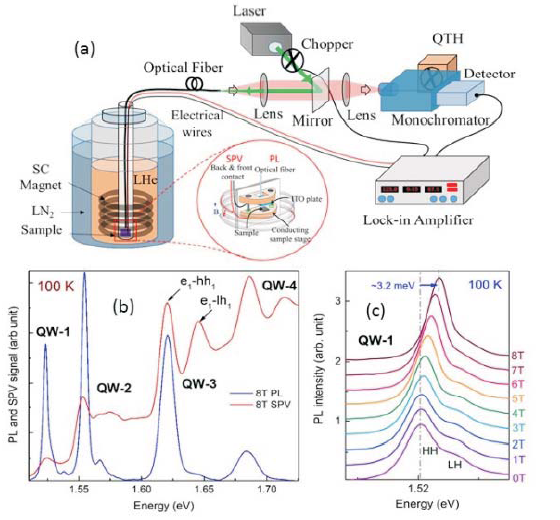|
Major Research Areas
Fundamental physics studies are being pursued with the help of following characterization techniques:
Magneto-optical measurements
Development and application of a magneto-
SPV and magneto-PL setup
Ultra-low disorder ( 10 ppb) in III-V semiconductor heterojunction
and quantum structures are important for making
numerous devices including laser diodes and photodetectors.
In order to enhance the device efficiency at the extreme
operating conditions, quantitative estimation of disorder
embedded in the system and its impact on the optoelectronic
processes are essential [1,2]. However, accurate measurement
of the density of radiative defects in such ultra-low
disordered system is a big challenge for most of the presently
available techniques. Recently, we have estimated the density
of disorders and effective mass of excitons for such ultra-low
disordered systems using magneto-photoluminescence
(Magneto-PL) technique [3,4]. These measurements are
performed at liquid helium temperature (4.2 K) where the
charge carriers are mostly occupied in the ground state of
semiconductor quantum well (QW) structures. However, the
excited states of a QW, are difficult to be probed via low
temperature magneto-PL measurements. Under high
intensity excitation conditions, one may see the signature of
excited state but it is not desired due to several complications
which might arise due to the sample heating and many body
effects. Under such condition, surface photo-voltage (SPV)
being a complementary technique can be highly beneficial for
obtaining complete information of the excitonic processes in
quantum structures. Generally, PL signal decreases with rise
in temperature and can be considerably feeble at room
temperature, which is not a problem in SPV measurements.
Thus, the impact of temperature and magnetic field on the
radiative and non-radiative processes in such quantum
structures can be understood via the simultaneous
measurement of SPV and PL spectra on QW samples. In view
of this, a compact experimental assembly was designed and
fabricated for the quasi-simultaneous measurement of
Magneto-SPV and PL as shown in Figure L.4.1(a). In this
experimental configuration, sample is kept inside a Dewar of
thermostat surrounded by liquid helium chamber with helical
shaped NbTi superconducting magnet, which can produce
magnetic field up to 8 T. An indium tin oxide coated semitransparent
conducting glass plate faces the sample under soft
contact mode as shown in the inset of Figure L.4.1(b). Laser
light for PL measurements is coupled to an optical fiber,
which transports the excitation light to the surface of the
sample. PL signal that comes out from the sample which is
then collected by the same optical fiber, and dispersed by a
spectrometer (IHR-320). In case of SPV measurements, the
same spectrometer is used to disperse the broad spectra from a
quartz tungsten halogen lamp, and coupled to the optical fiber.
The surface photo-voltage generated in the sample is then
collected by the ITO coated top electrode. The new
experimental assembly is found to be beneficial for gaining a
complete information on the dynamics of thermally excited charge carriers and the effect of magnetic field driven
confinement on the radiative recombination efficiency of
quantum structures.

(a) The schematic of sample mount for the quasisimultaneous
measurement of PL and SPV (b) Magneto-SPV
& PL spectra (c) Field dependent Magneto-PL spectra.
Representative magneto-PL and magneto-SPV spectra of a
GaAs/AlGaAs multi QW sample are shown in Figure
L.4.1(b). The spectra are recorded at 100 K under 8 T
magnetic field. It is obvious that the information related to the
ground and excited states of four QWs can only be obtained
by performing quasi-simultaneous magneto-PL and
magneto-SPV measurements. Magnetic field dependent
spectra is shown in the Figure L.4.1(c). Analysis of these
results can give clear information of the oscillator strength for
various electronic states of quantum structures under high
magnetic field. This kind of experiments would also be
beneficial for the simultaneous detection/measurement of
bright and dark excitons in semiconductor quantum
structures. The setup is specifically being used to investigate
the properties of QWs which are used for the development of
laser diode arrays and detectors.
[1] V. K. Dixit, S. Porwal, S. D. Singh, T. K. Sharma, S.
Ghosh, S. M. Oak, J. Phys. D: Appl. Phys.47, 065103
(2014).
[2] G. Vashisht, V. K. Dixit, S. Porwal, R. Kumar, T. K.
Sharma & S. M. Oak, J. Appl. Phys. 119, 095708 (2016).
[3] S. Haldar, V. K. Dixit, G. Vashisht, S.K. Khamari, S.
Porwal, T.K. Sharma & S.M. Oak, Scientific Reports 7,
4905 (2017).
[4] S. Haldar, V.K. Dixit, G. Vashisht, S. Porwal and T. K.
Sharma, J. Phys D: Appl. Phys 50, 335107 (2017).
Selected publications
-
Anisotropic magnetic properties of excitons in GaAs multiple quantum
wells, S. Haldar, A. Banerjee, Kranti Kumar, R. Kumar, Geetanjali
Vashisht, T. K. Sharma, and V.K. Dixit, Superlattices and Microstructure
137, 106332 (2020).
- A parallel magnetic field driven confinement versus separation of charges
in GaAs quantum well investigated by magneto-photovoltage and magnetophotoluminescence
spectroscopy, S. Haldar, A. Banerjee, Geetanjali
Vashisht, S. Porwal, T. K. Sharma, and V.K. Dixit, J. Lumin. 206, 342
(2019).
- Simultaneous magneto-electro-optical measurements in modulation doped
quantum well: An investigation on magneto-photoluminescence intensity
oscillations, S. Haldar, Geetanjali Vashisht, S. Porwal, T. K. Sharma, and
V. K. Dixit, J. Appl. Phys. 125, 205701 (2019).
- Radiative and non-radiative recombination of thermally activated magnetoexcitons
probed via quasi-simultaneous photoluminescence and surfacephotovoltage
spectroscopy, S. Haldar, V. K. Dixit, Geetanjali Vashisht, S.
Porwal and T. K. Sharma, J. Appl. Phys. 124, 055704 (2018).
- Effect of carrier confinement on effective mass of excitons and estimation of
ultralow disorder in AlxGa1-xAs/GaAs quantum wells by magnetophotoluminescence,
S. Haldar, V. K. Dixit, Geetanjali Vashisht, Shailesh
Kumar Khamari, S. Porwal, T. K. Sharma, and S. M. Oak, Nature Scientific
Reports 7, 4905 (2017).
|













